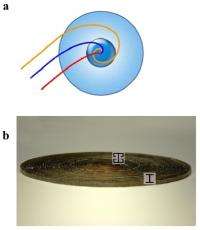October 16, 2009 weblog
Chinese scientists create metamaterial black hole

(Â鶹ÒùÔºOrg.com) -- Two physicists in China have used metamaterials to create the first artificial electromagnetic black hole. The scientists, Qiang Cheng and Tie Jun Cui from the Southeast University in Nanjing, China created the tiny black hole in their laboratory, in an experiment that aimed to simulate a black hole.
A black hole is a region from which no light can escape. In space, according to relativity theory, black holes are formed when the space becomes distorted by a large mass, preventing light from escaping its gravitational field, but any region from which no light escapes is a black hole.
The scientists exploited the special properties of metamaterials to create their mini black hole for microwave frequencies. Metamaterials are a class of ordered composites with properties not usually seen in nature. They are known to distort light, and have already been used to create invisibility cloaks that can steer light around an object. The Chinese scientists used their metamaterial to distort microwaves to the extent that those entering cannot escape.
The electromagnetic black hole was built from 60 strips of printed circuit boards coated with a thin layer of copper and arranged in concentric circles. The outer 40 strips form the shell, while the inner strips form the core. Intricate patterns were etched in the copper that alternately resonated and did not resonate at microwave frequency, and which changed progressively from strip to strip.
The scientists measured microwaves going into the device, and found none coming out. The microwaves entering the shell are trapped and guided towards the core, where they are absorbed in all directions equally because of the circular symmetry. The energy absorbed is emitted as heat.
The current device works only with microwaves, but they are aiming to develop a black hole for visible light next. This is more difficult because the wavelength of visible light is much smaller than microwaves, which means the etched structures must also be much reduced in size. Tie Jun Cui said he expected the visible light black hole to be demonstrated later this year.
An artificial visible light black hole could find practical uses in harvesting light for solar cells, and this could mean solar energy could be harvested even in places with diffuse sunlight.
More information: An electromagnetic black hole made of metamaterials, [physics.optics]
© 2009 Â鶹ÒùÔºOrg.com

















